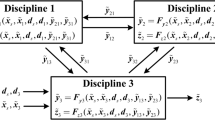Abstract
Collaborative optimization (CO) is a bi-level multidisciplinary design optimization (MDO) method for large-scale and distributed-analysis engineering design problems. Its architecture consists of optimization at both the system-level and autonomous discipline levels. The system-level optimization maintains the compatibility among coupled subsystems. In many engineering design applications, there are uncertainties associated with optimization models. These will cause the design objective and constraints, such as weight, price and volume, and their boundaries, to be fuzzy sets. In addition the multiple design objectives are generally not independent of each other, that makes the decision-making become complicated in the presence of conflicting objectives. The above factors considerably increase the modeling and computational difficulties in CO. To relieve the aforementioned difficulties, this paper proposes a new method that uses a fuzzy satisfaction degree model and a fuzzy sufficiency degree model in optimization at both the system level and the discipline level. In addition, two fuzzy multi-objective collaborative optimization strategies (Max–Min and α-cut method) are introduced. The former constructs the sufficiency degree for constraints and the satisfaction degree for design objectives in each discipline respectively, and adopts the Weighted Max–Min method to maximize an aggregation of them. The acceptable level is set up as the shared design variable between disciplines, and is maximized at the system level. In the second strategy, the decision-making space of the constraints is distributed in each discipline independently through the allocation of the levels of α. At the system level, the overall satisfaction degree for all disciplines is finally maximized. The illustrative mathematical example and engineering design problem are provided to demonstrate the feasibility of the proposed methods.
Similar content being viewed by others
References
Balling R and Rawlings MR (2000). Collaborative optimization with disciplinary conceptual design. Struct Multidisc Optim 20: 232–241
Balling RJ and Wilkinson CA (1997). Execution of multidisciplinary design optimization approaches on common test problems. AIAA J 35(1): 178–186
Bellman RE and Zadeh LA (1970). Decision-making in a fuzzy environment. Manage Sci 17(4): 141–164
Braun RD, Powell RW and Lepsch RA (1995). Comparison of two multidisciplinary optimization strategies for launch-vehicle design. J Spacecraft Rockets 32(3): 404–410
Goodrich MA (1990). A theory of satisficing decisions and control. IEEE Trans Syst Man Cybern A 28(11): 763–779
Gu X, Renaud JE and Ashe LM (2002). Decision-based collaborative optimization. ASME J Mech Des 124: 1–13
Huang HZ (1996). Reliability evaluation of a hydraulic truck crane using field data with fuzziness. Microelectron Reliabil 36(10): 1531–1536
Huang HZ (1997). Fuzzy multi-objective optimization decision-making of reliability of series system. Microelectron Reliab 37(3): 447–449
Huang HZ and Li HB (2005). Perturbation finite element method of structural analysis under fuzzy environments. Eng Appl Artif Intell 18(1): 83–91
Huang HZ, Tong X and Zuo Ming J (2004). Posbist fault tree analysis of coherent systems. Reliability Eng Syst Safety 84(2): 141–148
Huang HZ, Wu WD and Liu CS (2005a). A coordination method for fuzzy multi-objective optimization of system reliability. J Intell Fuzzy Syst 16(3): 213–220
Huang HZ, Li YH and Xue LH (2005b). A comprehensive evaluation model for assessments of grinding machining quality. Key Eng Mater 291–292: 157–162
Huang HZ, Gu YK and Du X (2006a). An interactive fuzzy multi-objective optimization method for engineering design. Eng Appl Artif Intell 19(5): 451–460
Huang HZ, Bo RF and Chen W (2006b). An integrated computational intelligence approach to product concept generation and evaluation. Mech Mach Theory 41(5): 567–583
Huang HZ, Wang P, Zuo Ming J, Wu WD and Liu CS (2006c). A fuzzy set based solution method for multiobjective optimal design problem of mechanical and structural systems using functional-link net. Neural Comput Appl 15(3–4): 239–244
Huang HZ, Zuo Ming J and Sun ZQ (2006d). Bayesian reliability analysis for fuzzy lifetime data. Fuzzy Sets Syst 157(12): 1674–1686
Jin F (1992). Satisfaction solution theory of neural computing. Sci Am 19(5): 49–55
Kroo I, Altus S, Braun R, Gage P, Sobieski I (1994) Multidisciplinary optimization methods for aircraft preliminary design. In: AIAA 94-4325-CP, proceedings of the 5th AIAA/USAF/NASA/ISSMO symposium on multidisciplinary analysis and optimization (held in Panama City, FL) 1:697–707
Simon HA (1996). The science of the artificial. MIT, Cambridge
Sobieski J, Kroo I (1995) Aircraft design using collaborative optimization. AIAA-96-0715, 34th aerospace sciences meeting and exhibit
Tappeta RV and Renaund JE (1997). Multiobjective collaborative optimization. ASME J Mech Des 119: 403–411
Takatsu S (1981). Latent satisficing decision criterion. Inf Sci 25: 145–152
Wang G (1992). Theory of soft design in engineering. Science Press, Beijing
Zadeh LA (1975). The concept of a linguistic variable and its application to approximate reasoning-I. Inf Sci 8: 199–249
Zuang X, Liang Y, Yuan A and Dong S (1999). Mulitiojective fuzzy optimization of mechanical structures. J Harbin Inst Technol 31(5): 14–17
Author information
Authors and Affiliations
Corresponding author
Rights and permissions
About this article
Cite this article
Huang, HZ., Tao, Y. & Liu, Y. Multidisciplinary collaborative optimization using fuzzy satisfaction degree and fuzzy sufficiency degree model. Soft Comput 12, 995–1005 (2008). https://doi.org/10.1007/s00500-007-0268-6
Published:
Issue Date:
DOI: https://doi.org/10.1007/s00500-007-0268-6




